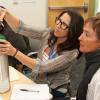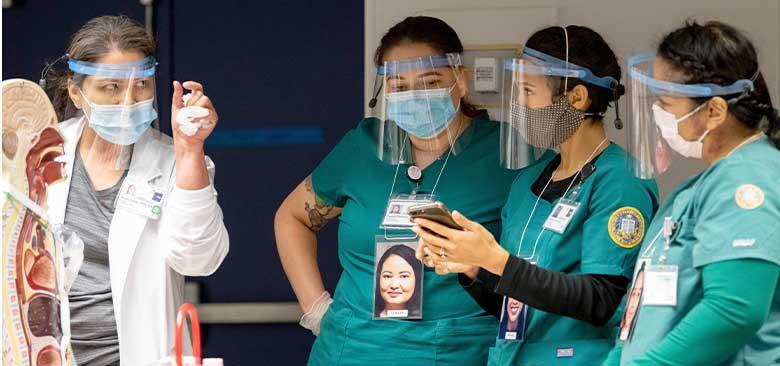
While a large portion of the students’ education is occurring remotely, small groups of students are returning to campus for essential experiential learning, including students in the Master's Entry Program in Nursing. (Photo credit: Susan Merrell)
How UCSF’s Nursing School Is Innovating Education Amid a Global Pandemic
As the UCSF School of Nursing’s new Assistant Dean for Education Technology Innovation, Elizabeth Gatewood was charged with growing the School’s use of technologies to enhance students’ academic learning. She had four months from her February appointment to develop a strategy and plan.
Then COVID-19 struck. In mid-March, California Gov. Gavin Newsom issued a statewide stay-at-home order, forcing schools, employers and other organizations to transition to remote working and learning.
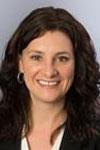 Elizabeth Gatewood “It went from having four months to formulate a vision and work plan to ‘how do we get the School online immediately? How do we support faculty and learners in an online environment and what does that look like?’ ” she said.
Elizabeth Gatewood “It went from having four months to formulate a vision and work plan to ‘how do we get the School online immediately? How do we support faculty and learners in an online environment and what does that look like?’ ” she said.
As the pandemic seized daily routines and turned them upside down, faculty and staff at the School quickly shifted to remote instruction to ensure that nursing students continue their academic progress uninterrupted. Gatewood and her team rolled out training to faculty to prepare them for remote delivery. Program directors switched all academic courses to videoconferencing. Faculty embraced virtual patient simulation software. The Office of Clinical Placements worked to facilitate new clinical opportunities for students.
“It was an uphill sprint,” Gatewood said.
These efforts paid off. Despite the challenges of a global public health crisis, 189 nursing students from the Class of 2020 completed their programs and earned their master’s or doctoral degrees — on par with past non-pandemic years.
Transitioning to Remote Learning
It all began in March when, like other institutions around the country, UCSF needed to rethink how to educate and engage its students. Step one was shifting more than 100 nursing didactic courses to the Zoom videoconferencing platform. The technological transition achieved its primary objective of resuming courses, but surveys the School conducted to understand students’ needs found that some students struggled to retain information in the new format.
To address this issue, Gatewood and her team, XinXin Huang and Kaori Keller, provided tools to help faculty design remote-learning courses that fit students’ needs. She hosted live webinars on the basics of remote instruction, such as the difference between asynchronous and synchronous courses and how to conduct exams. She leveraged the expertise of faculty with experience in remote instruction, especially those in the School’s hybrid Doctor of Nursing Practice program. Professor Lisa Lommel led a faculty session on remote instruction and assistant professor Marianne Hultgren presented on boosting student engagement.
To ensure consistent support, Gatewood’s Ed Tech team holds virtual drop-in hours twice a week. In 2020, they held 65 sessions to support faculty with their remote instruction needs.
Professor Maureen McGrath was apprehensive at first about shifting her Behavioral Approaches to Diabetes course to Zoom because one of the course’s most important elements is its 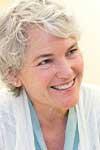 Maureen McGrath interactivity. But she found Zoom’s breakout room feature replicated the intimacy her students experience in-person and she was thrilled to find that post-course student evaluations were overwhelmingly positive.
Maureen McGrath interactivity. But she found Zoom’s breakout room feature replicated the intimacy her students experience in-person and she was thrilled to find that post-course student evaluations were overwhelmingly positive.
“It was incredible to see the response be so kind and complimentary, and that they were appreciative of the quick conversion,” McGrath said.
McGrath mailed glucose meters, saline and needles to her students, including one isolating on the East Coast, as part of an exercise in which students simulate having diabetes. She then walked them through the procedures via Zoom.
“Their experience in the course might have been completely different if not for that scaffolding activity where they experience what patients go through so they can build empathy for them,” McGrath said.
Nursing students are also honing their patient evaluation skills through virtual simulation software that the School has adopted. These interactive, life-like experiences allow the students to practice key skills in diagnostic reasoning and patient assessment.
While a large portion of the students’ education is occurring remotely, small groups of students are returning to campus for essential experiential learning. The university has implemented extensive health and safety protocols to reduce exposure to the coronavirus, including mandatory health screenings before arriving on campus, equipping every individual with their own personal face shield, providing face masks and gloves, and frequently sanitizing all equipment.
Delivering Care Through Telehealth
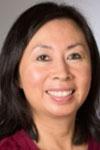 Miranda Surjadi While creating an engaging remote environment for didactic courses, the School’s leadership and clinical placements team, led by Supervisor Tammy Ryan, simultaneously worked to facilitate alternative placements for its students when some clinical sites stopped accepting students during the pandemic.
Miranda Surjadi While creating an engaging remote environment for didactic courses, the School’s leadership and clinical placements team, led by Supervisor Tammy Ryan, simultaneously worked to facilitate alternative placements for its students when some clinical sites stopped accepting students during the pandemic.
“We had to rethink different ways for them to gain experience,” said Miranda Surjadi, associate professor at the School of Nursing.
Telehealth served as a bridge. About 30 students supported UCSF’s COVID-19 response by triaging patient calls, providing patient education by phone and performing contact tracing. Some, like Sudha Lama (MS ’20), continue to work as contact tracers for UCSF Occupational Health Services.
“This experience is gold for me as a new grad,” Lama said. “To see how people are strategizing at institutional and government levels gives you a really unique perspective.”
Second-year master’s student Carly Wisnowski, whose clinical rotation involved home visits with elderly patients through the Care at Home program, said it took her a few months to get comfortable with telehealth. The inability to conduct physical examinations strengthened her observational skills as well as her abilities to document a patient’s history.
“The physical exam takes a back seat so you have to pay attention to subtle things like how they are speaking or whether they are short of breath,” she said. “It’s very important to ask the right questions.”
Professor Gerri Collins-Bride said, “It’s been a huge transformation, but we’ve found a joyful new way to deliver care. Students are becoming more comfortable with telehealth and are 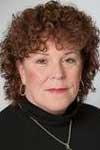 Gerri-Collins Bride taking away important skills.”
Gerri-Collins Bride taking away important skills.”
What the Future Holds
The transition to remote learning has inspired new innovations to improve student engagement and patient outcomes.
The School plans to continue using virtual patient simulation software and has created a task force to investigate incorporating it into the learning environment in a post-pandemic era.
Gatewood is seeking a grant to fund a telehealth curriculum for the School of Nursing as well as the UCSF School of Pharmacy and Department of Physical Therapy. The curriculum would focus on foundational and interprofessional principles, diversity, equity and inclusion, and professionalism. It could be implemented next academic year, if funding is approved.
Gatewood is excited about the hybrid learning models that can be developed once the pandemic ends. While many students are eager to return to the physical classroom, some will prefer to learn remotely, reducing their commutes and time away from their families.
“This is going to move us forward,” Gatewood said. “We’ve made a lot of changes and I’m excited about the future.”


